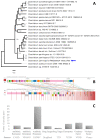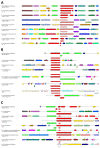Genomic Insights into Virulence Factors and Multi-Drug Resistance in Clostridium perfringens IRMC2505A
- PMID: 37368661
- PMCID: PMC10302382
- DOI: 10.3390/toxins15060359
Genomic Insights into Virulence Factors and Multi-Drug Resistance in Clostridium perfringens IRMC2505A
Abstract
Clostridium perfringens is a spore-forming, Gram-positive anaerobic pathogen that causes several disorders in humans and animals. A multidrug-resistant Clostridium strain was isolated from the fecal sample of a patient who was clinically suspected of gastrointestinal infection and had a recent history of antibiotic exposure and diarrhea. The strain was identified by 16s rRNA sequencing as Clostridium perfringens. The strain's pathogenesis was analyzed through its complete genome, specifically antimicrobial resistance-related genes. The Clostridium perfringens IRMC2505A genome contains 19 (Alr, Ddl, dxr, EF-G, EF-Tu, folA, Dfr, folP, gyrA, gyrB, Iso-tRNA, kasA, MurA, rho, rpoB, rpoC, S10p, and S12p) antibiotic-susceptible genetic species according to the k-mer-based detection of antimicrobial resistance genes. Genome mapping using CARD and VFDB databases revealed significant (p-value = 1 × 10-26) genes with aligned reads against antibiotic-resistant genes or virulence factors, including phospholipase C, perfringolysin O, collagenase, hyaluronidase, alpha-clostripain, exo-alpha-sialidase, and sialidase activity. In conclusion, this is the first report on C. perfringens from Saudi Arabia that conducted whole genome sequencing of IRMC2505A and confirmed the strain as an MDR bacterium with several virulence factors. Developing control strategies requires a detailed understanding of the epidemiology of C. perfringens, its virulence factors, and regional antimicrobial resistance patterns.
Keywords: Clostridium; anaerobic pathogen; genome mapping; multi-drug resistant; resistance genes; virulence.
Conflict of interest statement
The authors declare no conflict of interest.
Figures



References
-
- Ueda K., Kawahara K., Kimoto N., Yamaguchi Y., Yamada K., Oki H., Yoshida T., Matsuda S., Matsumoto Y., Motooka D., et al. Analysis of the complete genome sequences of Clostridium perfringens strains harbouring the binary enterotoxin BEC gene and comparative genomics of pCP13-like family plasmids. BMC Genom. 2022;23:226. doi: 10.1186/s12864-022-08453-4. - DOI - PMC - PubMed
MeSH terms
Substances
LinkOut - more resources
Full Text Sources
Molecular Biology Databases
Miscellaneous

